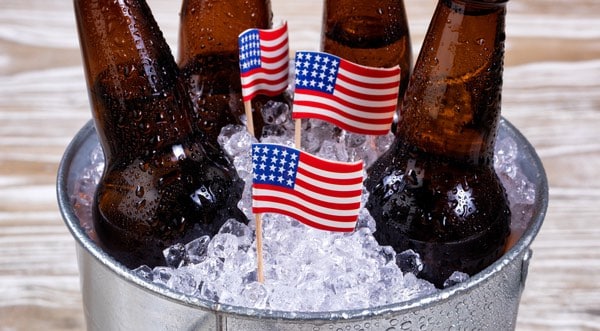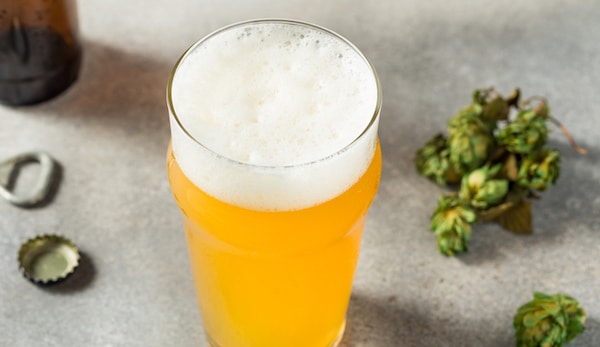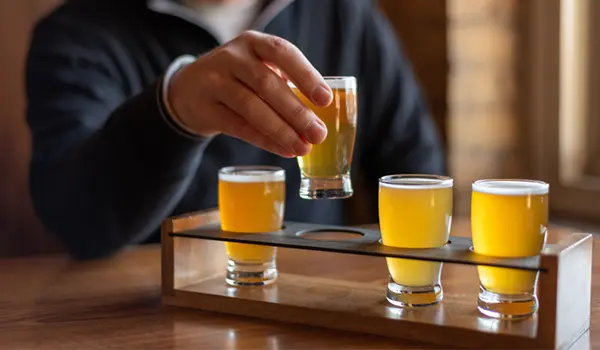
In This Article
- Introduction
- What Makes a Beer Good for Beginners?
- Easiest Beer Styles for New Drinkers
- 5 Beginner-Friendly Craft Beers to Try
- Tips for Enjoying Your First Beers
- What to Avoid as a Beer Beginner
- Beginner Beer Tasting Guide
- At-a-Glance: Beginner Beer Style Chart
- Conclusion: Your Beer Journey Starts Here
Introduction
Craft beer newcomers might see people downing IPAs or sours at the pub and wonder where these veteran drinkers started. Did they just decide they like imperial stouts and start drinking them one day? Craft beer has been an intimidating world for the uninitiated. There are so many styles, so many breweries, so much information. And the beer itself? Double IPAs with 18 different hops in them? Imperial Stout aged in Bourbon Barrels? Half of these beers have names in German or French! How can a beginner possibly get into craft beer with all these obstacles?
While it may seem daunting, getting into craft beer isn’t all that difficult. While there are many (perhaps too many) bold and extreme beer styles available, there are equally as many approachable and drinkable beers that are perfect for new palates. Styles like blonde ale, pilsner, and Kölsch are crisp and clean, while wheat beers and pale ales bring the flavor without overwhelming.
There are plenty of places to start. Here’s everything you need to know:
RELATED:
Best Beers for Women: Popular Beers Ladies Will Love
Lowest Calorie IPAs: Best Tasting Beers Under 100 Calories
What Makes a Beer Good for Beginners?
A beginner-friendly beer is usually one that avoids harsh extremes. Look for these qualities when choosing your first craft brew:
- Low Bitterness: Overly hoppy IPAs are intimidating, so seek out milder hop profiles without harsh or overwhelming bitterness. There’s a sensation called “hop burn” that some beer geeks have experienced… Avoid that!
- Low to Moderate Alcohol: ABVs of 4–6% are ideal for beginners because the booze won’t sneak up on them, and the flavors won’t have strong alcohol warmth.
- Light to Medium Body: Lighter-bodied beers will go down easier and be more refreshing, especially for new palates.
- Clean Finish: Beers with a crisp, dry finish will have minimal aftertaste and be more approachable.
- Slight Sweetness: Mild malt sweetness, usually “bready” or a light caramel, makes beers smoother and drinkable than the cloying sweetness of some stouts.
- Fruity Esters: Banana or citrus aromas (often found in wheat beers or pale ales) are familiar and pleasant without being overwhelming.
- Low Carbonation Bite: Smaller and fewer bubbles help with drinkability, and these beers take less time to pour.
- Balance is Everything: A nice mix of malt and hops that don’t overpower each other is easier to drink and enjoy.
Easiest Beer Styles for New Drinkers
Blonde Ales
These are some of the lightest styles of ale available. Light and drinkable, these beers will have slightly fruity flavors and aromas from the yeast (especially the Belgian versions). Ideal for pairing with cheeses and other snacks.
Good example: Kona Big Wave, Leffe Blonde
Hefeweizen / Wheat Beer
Smooth-drinking with slightly fruity and spicy aromas, these beers will have clove and banana flavors and a citrus kick. Perfect for patio drinking! The fluffy foam and medium body help the beer go down smoothly. Low alcohol content makes it ideal for beginners.
Good example: Weihenstephaner Hefeweissbier, Allagash White
Cream Ale and Golden Ale
Light-bodied and smooth with a subtle sweetness, this is the closest you’ll get to a light lager while maintaining a nice flavor. Ideal for patio drinking, and they pair nicely with almost anything.
Good example: Genesee Cream Ale, New Glarus Spotted Cow
Kölsch
This German-style ale drinks like a lager, but it’s as crisp and clean-drinking as it gets. These are lighter in alcohol and have low carbonation, making them very easy to drink. Ideal for pairing with German sausages, schnitzel, or even a hot dog at the ballpark.
Good example: Reissdorf Kölsch, Früh Kölsch, Goose Island Summertime
Pilsner
The original hoppy beer, these German and Czech lagers are easy to drink but full of flavor. Light and refreshing, there’s a soft bitterness from the hops with a dry finish. There are macro-lager versions meant for drinkability along with full-bodied craft or traditional versions that pack in the flavor.
Good example: Pilsner Urquell, Stella Artois, Oskar Blues Yella Pils
Milk Stout
Dark beer is usually reserved for seasoned drinkers, but these sweet and creamy ales are ideal for beginners. Familiar flavors like coffee and chocolate make for easy reference points. The low alcohol, despite being slightly filling, makes a milk stout perfect for drinkers trying not to overindulge.
Good example: Left Hand Milk Stout Nitro
Pale Ale
The lowest ABV hoppy beer, this is perfect for getting your piney hop aromas without the booze of an IPA. Pale ales aim to balance the subtle malt sweetness and grassy hop bitterness. There are excellent pale ales from legacy craft brewers available anywhere. If you’re ever going to get into IPA, pale ales are the way to start.
Good example: Sierra Nevada Pale Ale, Oskar Blues Dale’s Pale Ale
5 Beginner-Friendly Craft Beers to Try
Oskar Blues Mama’s Little Yella Pils
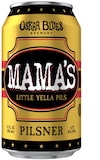
- Pilsner | 4.7% ABV
- This Colorado staple is proof that a well-made pilsner can hold its own in a world full of hop bombs and pastry stouts. A gold-medal winner that’s available almost everywhere, Mama’s Little Yella Pils is brewed with German specialty malts and traditional Saaz hops, giving it the kind of authenticity you’d expect from a beer twice its price.
- It pours pale and bright with a delicate floral aroma, backed by just enough malt sweetness to keep things balanced. Crisp, snappy, and endlessly refreshing, it’s the kind of beer you can drink all day without ever getting bored.
Sierra Nevada Pale Ale
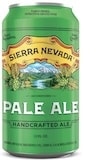
- American Pale Ale | 5.6% ABV
- Arguably the beer that kicked off the American craft revolution, Sierra Nevada Pale Ale has been converting light lager drinkers into hop fans since the early ’80s. It’s bold enough to make an impression but balanced enough to remain a fridge staple decades after its debut.
- Cascade hops deliver a burst of citrus and pine on the nose, while the malt backbone smooths things out for a clean, easy finish. The result is a timeless pale ale that still feels fresh no matter how many times you’ve had it.
Left Hand Milk Stout Nitro

- Milk Stout (Nitro) | 6.0% ABV
- If you’ve ever been intimidated by the inky pour of a stout, this is the one to change your mind. Left Hand’s Milk Stout Nitro has a devoted following thanks to its cascading nitro pour and velvety texture, transforming a robust style into something smooth and approachable.
- Chocolate and coffee notes lead the way, with a touch of sweetness from lactose rounding things out. With no bitterness to speak of, it’s as close to a dessert in a glass as you can get without a spoon.
Goose Island Summertime
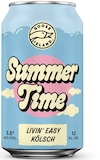
- Kölsch | 5.6% ABV
- Summer beers don’t get much more classic than a well-made Kölsch, and Goose Island nails it with Summertime. Brewed in the style’s German homeland tradition, it’s light, crisp, and low in bitterness—perfect for long afternoons outside.
- Gentle floral aromas give way to a soft malt character and a clean, dry finish. It’s subtle in all the right ways, offering refreshment without ever trying to steal the spotlight.
Bell’s Oberon Wheat Ale
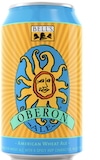
- American Wheat Ale | 5.8% ABV
- For beer fans in the Midwest, Oberon’s return each year is as sure a sign of spring as the first backyard BBQ. Brewed with wheat malt for a pillowy body and a touch of spice, it’s approachable enough for newcomers yet flavorful enough for seasoned drinkers.
- Hints of citrus brighten the malt base, creating a beer that’s as easy to drink as it is to love. Whether you’re on a patio or at the beach, Oberon feels like summer in a glass.
Tips for Enjoying Your First Beers
- Use a glass: Drinking straight from the bottle or can is fine for a barbecue, but being able to see and truly smell the beer is preferable.
- Pair the right beer with the right food: Do a little bit of research about your beer of choice to know what works best for it (e.g., wheat beer with seafood and Pilsner with grilled chicken).
- Don’t judge a beer style after one sip: Each beer category has good and bad examples, so don’t jump to conclusions and try a few versions.
- Keep the IBUs low: “International Bitterness Unit” measures the perceived bitterness of a beer. It’s best to keep things low, so seek out beers with 40 or fewer IBUs when first starting.
- Sampler packs: Or create your own six-pack options are perfect for exploring.
What to Avoid as a Beer Beginner
- Avoid IPAs or double IPAs if you dislike bitterness!
- Skip barrel-aged stouts unless you like whiskey/bourbon flavors.
- Opt for kettle/fruited sour beers instead of wild ales or lambics. Your palate will need to adjust to the acidity before you can truly enjoy these beers.
- Stay away from expensive beers, at least at first.
Beginner Beer Tasting Guide
- Start with a Blonde Ale – If you want the closest thing to the light lager you drank in college but want flavor, this is your best bet!
- Move to a Wheat Beer – It offers the most drinkability and will ease you into bolder flavors.
- Try a Pilsner – Your introduction to hops will go down smoothly with this drinkable but flavorful lager.
- Move on to Pale Ale – Don’t deep dive into an IPA! Opt for a drinkable hoppy ale, to be safe.
- End with a Milk Stout – If you’re curious about dark beers, opt for a smooth and creamy stout that’s low in alcohol and perfect for dessert.
At-a-Glance: Beginner Beer Style Chart
| Beer Style | Color | Bitterness (IBU) | Flavor Notes | ABV | Example |
|---|---|---|---|---|---|
| Blonde Ale | Pale gold | Low | Light malt, slight fruit | 4.5% | Kona Big Wave |
| Wheat Beer | Hazy yellow | Low | Banana, clove | 5.0% | Weihenstephaner |
| Pilsner | Pale straw | Medium | Crisp, floral | 4.8% | Pilsner Urquell |
| Radler | Pale | Very low | Citrus, soda-like | 2.5% | Stiegl Grapefruit |
| Milk Stout | Dark brown | Low | Chocolate, coffee, creamy | 5.2% | Left Hand Nitro |
Conclusion: Your Beer Journey Starts Here
Whether you’re just turning 21 or tired of wine or spirits and want to explore the world of craft beer, there are enough delicious but drinkable options to ease your way in. Use indicators like ABV or IBU to find what might appeal to your palate, but don’t forget to explore new flavors! It’s important to note that there are many beer styles, so keep an open mind when ordering at the pub.
Cheers to your next (or first!) favorite beer.




